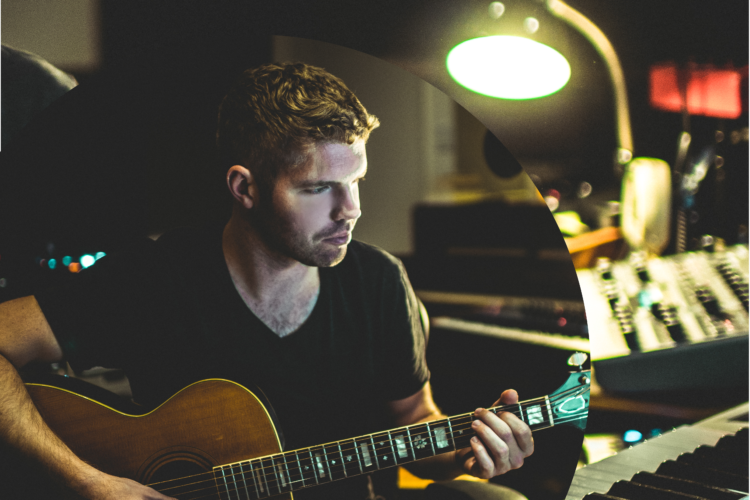Morgan Page’s 2008 single “The Longest Road (feat. Lissie)” is without doubt one of the most important records in modern US electronic music, captivating the hearts and imaginations of a new generation of clubbers upon its release.
To celebrate its 10th anniversary, Morgan Page brought the opportunity to remix the influential track to Splice. As submissions for the contest wrap up, we sat down with Morgan Page to discuss what it was like both recording the song 10 years ago and unearthing the session in 2018.
Can you tell us about how you and Lissie wrote “The Longest Road?” What was your studio setup and workflow like back then?
10 years ago, Lissie and I wrote “The Longest Road” inside a cramped Silver Lake apartment. It was a true bedroom studio – the mattress would often need to be moved to record vocals, and I shared the apartment with two other roommates. Neighbors would often complain and leave notes like “please turn down the kick drum.” Lissie sang her vocals behind me using a $200 Studio Projects C1 mic, and we used a ‘stream of consciousness’ method of writing – I’d loop the entire instrumental for 3 or 4 passes, go the kitchen to brew coffee, and then comp the vocals from there. It was extremely tedious because the vocals were only written in fragments without any lyrical structure. Later, we pieced together the puzzle by slicing and dicing in the DAW and arranging the song into proper sections, on paper and then on the computer, until it clicked.
I don’t recommend this method of working, but it’s worth trying a stream of consciousness session in some form – just don’t get bogged down with polishing the atoms until you build the foundation. It’s easy to get distracted with background vocals and ear candy, only to realize that the core lyrical concept is flawed.
Were there some production techniques or workflow elements from 10 years ago that stood out to you upon digging up the session for the track? How did you and Lissie craft the distinctive sound of this track that still more than holds up today?
Digging up a session from 10 years ago is a lesson in itself. You see all the flaws: the pops, clicks, headphone bleed, and missing fades. The breaths that should’ve been ducked a bit more, phasing on double takes, timing that could’ve been nudged a bit more, auto-tune warbles that could’ve been refined, and EQ choices that could’ve been better. But the flaws gel into something special. The vocals have a tension and grittiness to them. They aren’t polished to perfection. Some takes were recorded too hot – a delicate balancing act with all dynamic vocalists. I took a lot of time getting my version of ‘the Lissie sound,’ so that when we collaborate on a song, it sounds like Lissie and Morgan Page, not just a faceless top liner (although they’re great too)! You can’t mistake the sawdust of Lissie’s voice. These are the kinds of vocals I strive to record, and I can feel the difference when it’s a remote session with another engineer. Inevitably you have to delegate the work at some point, and you’ll lose perspective if you hear the same song an extra 400 times.
Yet, looking back at these sessions, the ones recorded in studio were some of my biggest records. Lissie and I crafted a special sound using traditional techniques: the usual doubles, harmonies, lowest intensity with pitch, and whisper takes that are all breath, without pitch. They weren’t overly-quantized with plugins like Vocalign, just tediously dragged across on the grid. I compressed things very lightly going in, mainly using an Avalon 737 as a pre-amp and tube EQ. All the processing was stock Pro Tools compressors. The real processing was in the curation of the vocal takes compiled and the vocal layering choices.
What are some lessons you took away from revisiting the session for “The Longest Road?”
Looking back, I see how important it is to properly archive sessions in a universal format. Always bounce down to stems. Don’t expect your sessions to open, even if all of the original plugins are still installed. It’s scary that all of that work can be lost simply because you didn’t take an hour to properly consolidate, freeze, flatten, save a session copy, and archive.
Plugin formats and compatibility change, companies go out of business, and hard drives crash. Often times the plugin will gray out so you can’t even see what needs to be re-installed! Take a moment to go through your sessions and save alternate versions where every plugin is flattened. Make stems with and without sidechain processing. Print a version of the vocals with the tuning. Make sure none of your shared effects are ghosting with the vocal reverb (when the vocal reverb is present in the instrumental). Print all of your outboard effects. The constant upgrade process will be a problem when you’re opening a session and iZotope is on Ozone version 18. It’s probably worth saving a legacy installer folder, because those plugins might be gone. Make sure to export the MIDI data for the chord progressions, basses, and leads. Leave a marker in the session with tempo and key data. Make sure to bounce files in 24 bit or 32 bit if possible. WAV is probably best for compatibility – but this still drives me nuts for masters, since AIFF is better for retaining metadata and artwork.
Will you be able to open your sessions in 10 years when a lucrative sync deal comes calling for a Super Bowl ad and they want an updated mix? Will you even be able to boot that computer up and transfer the media? These problems don’t have easy solutions – the only solution is to bounce your stems right now.
Any other issues to look out for or things to keep in mind when it comes to opening old sessions?
Below, I’ve compiled some common issues with opening old sessions:
- Hardware incompatibility (ex: when Apple changed their chipsets)
- OS incompatibility (always wait on upgrades until you’re forced to change)
- Plugin authorization method changes, missing licensor keys, lapsed authorizations/NFRs
- Missing proprietary hardware
- Unavailable legacy installers
- The plugin manufacturer is acquired or goes out of business
- Media failure (Hard drives fail, CDs and DVDs corrode)
- Bad session exports: missing fades, audio files, key session files, bad folder hierarchy, etc. – in Ableton it’s simple, but in Pro Tools you have to check the right boxes
Check out the remix contest for “The Longest Road” and entries from the Splice community here.
December 10, 2018



